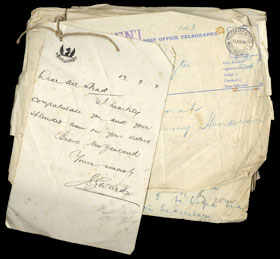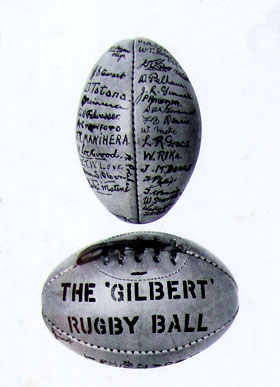Hocken marks major sporting event with exhibition of rugby history
Monday 5 September 2011, 4:31PM
467 views
In a special event to mark the Rugby World Cup games in Dunedin, the University of Otago’s Hocken Library has put on an exhibition entitled ‘Ruck It! How Otago Shaped Rugby History.’
Curator of Pictorial Collections Natalie Poland says the public exhibition, which opens today in the Hocken Library foyer and runs until 26 November, examines the contributions that Otago people have made to the development of rugby by showcasing a sample of this rich history.
Drawn from the Hocken’s own collections, the show features rugby memorabilia, early rugby publications, official team photographs and personal scrapbooks.
“Players and coaches from southern New Zealand, and especially Otago Maori, have had a major role in the development of the national and international game since rugby was introduced in the 1870s,” she says.
“The modern scrum and rucking - hallmarks of an uncompromising style of play – both originated here in Otago. And Otago Rugby Football Union and University Club players have strengthened the All Blacks with their southern spirit.”
She adds that it is especially fitting that the Hocken holds this exhibition, since the Library, which is a major national resource of archives, photographs and art, is physically located a very short distance from the new Stadium and international rugby venue on Anzac Avenue.
The Hocken holds a large collection of records from the Otago Rugby Football Union, including minute books, clippings books; O.R.F.U. Annuals, and correspondence files.
The show focuses on the contributions of Billy Stead (Vice Captain of 1905 All Black team tour of Britain and co-author of classic manual The Complete Rugby Footballer) and Otago born Maori rugby players and managers, Ned Parata, Tom Ellison (author of The Art of rugby football) who also profoundly influenced the development of the game. Other individuals who have contributed to the development of the sport including Vic Cavanagh Senior and Junior, of Dunedin, who developed the modern scrum and rucking in the 1930s.
Exhibition Details
Venue: Hocken Library Foyer, 90 Anzac Ave.
Key objects include Tom Ellison’s The Art of Rugby Football (1902) that shows why he is known as one of the game’s great innovators. Ellison was introduced to rugby by his Taiaroa cousins at Otakou around 1881. He was a prominent member of the New Zealand Native Football Team, which toured Great Britain and Australia in 1888 and would later captain the 1893 New Zealand team on their tour of Australia. It was his suggestion that the New Zealand team should adopt Native team uniform of the black jerseys with a silver ferns. The 2-3-2 scrum formation that he developed for his Poneke club team in Wellington became the dominant style of All Black play until the 1930s.
Southland boot-maker, Billy Stead had an enduring influence on Maori and All Black rugby. Billy Stead was a member of the first official New Zealand tour of Britain and France in 1905-06. He was the team’s vice-captain and chief tactician. He wrote regular columns for the Southland Times and at the end of the tour, combined with captain David Gallaher to write one of the earliest rugby classics, The Complete Rugby Footballer. He played 32 games for the All Blacks, 12 of them as captain, he was part of the first Maori team and was later a referee, coach and manager. Hocken’s collection of papers includes a scrapbook, photographs, a bunch of victory telegrams, and a copy of his book.
Ned Parata, from Puketeraki, Karitane, is widely regarded as the father of Maori rugby. The parallel development of Māori rugby was one of the defining characteristics of New Zealand rugby. Wiremu Teihoka (Ned) Parata organised the first Māori team in 1910 and persuaded Billy Stead to come out of retirement to play for it. Parata, who underwrote the cost of touring from the profits of his motor car business, continued to organise Māori rugby for the next 20 years, climaxing in the 40-match tour of Europe and Canada over the summer of 1926-27. This is his scrapbook; it contains photographs, letters and newspaper clippings relating to the tour.
J W Stewart’s album features the celebrated Maori rugby tour of France, Britain and Canada led by Ned Parata. This album contains photographs, newspaper clippings and ephemera relating to the New Zealand Maori rugby tour of Great Britain, France and Canada, 1926-1927. It also has photographs of Palmerston, North Otago and South Island Maori teams. J. Stewart appears in many of these photographs and has been attributed as the creator of the album.
Exhibition themes include:
- The contribution Otago personalities have made to the game
- Grassroots rugby - the Carisbrook experience, selected highlights of rugby played at Carisbrook’
- Otago University Rugby Club - Scarfie supporters, Otago University players
An extended version of the exhibition will be on display 17 Sept – 30 October 2011 at ‘The Link’ in the University’s ISB Building, Cnr Cumberland & Albany St.s. That display will include an additional section that focuses on how the University has contributed to the national game including the development of special textiles and links between rugby and scientific research at Otago.

